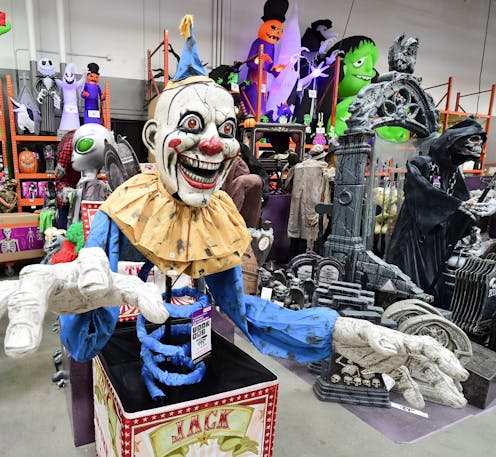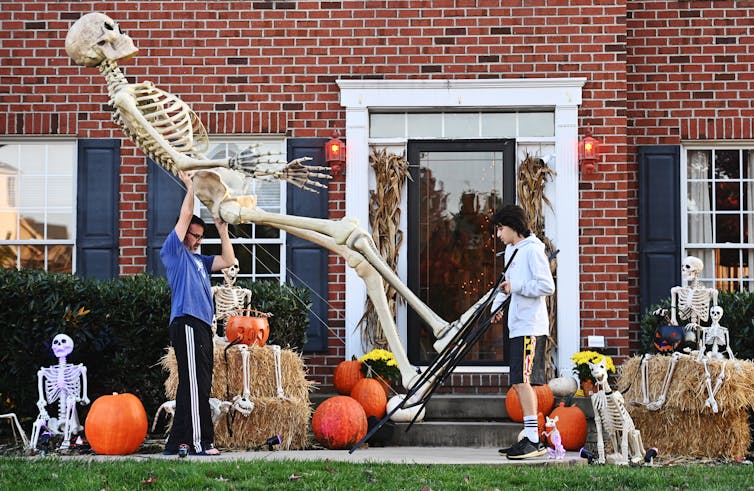
Halloween was once a time of both tricks and treats. Lately, Halloween has become one big treat for businesses, with consumers spending an estimated US$11.6 billion on this one-night holiday. That’s roughly the same amount of money as Americans spend on children’s books each year.
This massive amount of spending is puzzling, given the media is filled with stories about the economic hardships many families face.
As a business school professor who has written previously about Halloween, I was curious why Halloween spending is just below all-time highs at the same time many people report high levels of economic angst.
Americans spend billions every Halloween
The best data on Halloween spending comes each year from the National Retail Federation, which surveys Americans about their shopping plans just before the holiday. It found that U.S. consumers will spend over $11 billion this year, which is about half the amount spent annually on dental care for children under age 17.
The most recent survey also shows that about three out of four Americans will celebrate in some fashion. Because not everyone observes the holiday, the federation calculates that the typical person celebrating will spend $104 on Halloween.

The federation breaks down spending into four categories. About one-third of spending will be on costumes for children, adults and pets. Another third will be spent on decorations like giant skeletons. About a final third is spent on candy, and the remaining sliver is spent on greeting cards.
Back in 2005, the federation estimated the holiday would generate only $3.3 billion of spending. This means Halloween spending has grown dramatically, by about three and a half times, in just two decades, or about double if we are adjusting for inflation.
Unmasking the causes of rising Halloween spending
What has driven Halloween spending skyward? Some of the growth is due to inflation, which has increased prices by about 65% over the past two decades. Some of the growth is due to more people living in the U.S. In 2005, the U.S. had about 290 million people, while today the figure is closing in on 340 million.
While these two factors explain some of the growth, they don’t explain it all.
To understand more, I looked at some government data:
The U.S. tracks what the typical family spends on a wide variety of products and services to measure the cost of living. Spending each year is monitored via the Consumer Expenditure Survey. This survey has publicly provided data on annual candy spending since 2013, when it found the typical family spent $88 a year on candy.
The latest figures for 2023 show U.S. families have developed a very sweet tooth: Candy spending by the typical family is now at $164, which means candy outlays have almost doubled from a bit over a decade ago.
While this increase in candy consumption undoubtedly boosts spending at Halloween, it also has a downside. The American Dental Association has shown a dramatic increase in spending at the dentist office, as many people make emergency dentist visits as teeth get cracked on candy.
Spending on costumes has also soared.
In 2005, the best estimate was that $1.2 billion would be spent on just dressing up, while this year the figure is $3.8 billion.
Why so much? Costumes used to be just for children, but today many adults are dressing up. About 1 in 5 adults say they will be wearing a costume for Halloween. Beyond costumes for people, Americans spend millions of dollars on costumes for their pets.
The National Retail Federation has not tracked my favorite Halloween category, pumpkin sales, but the U.S. Department of Agriculture has. When I was young, each family in my neighborhood typically had one pumpkin on their doorstep. Now, I routinely see houses with many – both in my old neighborhood and my new one, which is a few miles away in another part of Boston.
It seems it’s not just my neighbors who are buying more gourds. In 2005, the USDA calculated that there were about four and a half pounds of pumpkins for sale for every person just before the holiday. In 2023, the amount had risen to almost six pounds per person. This means there are about 50% more pumpkins available for carving and for making pies.
While polls suggest many Americans are feeling financially fragile, the data indicates it isn’t having much impact on Halloween spending. After all, over the past two decades, Halloween has become an ever-bigger commercial holiday.
Halloween can be scary, but it doesn’t have to be scary for your finances. If you are struggling financially this year, before buying on credit giant candy bars that only get half-eaten, or cute pet costumes most animals probably don’t want to wear, think about maybe cutting back.
Jay L. Zagorsky does not work for, consult, own shares in or receive funding from any company or organization that would benefit from this article, and has disclosed no relevant affiliations beyond their academic appointment.
This article was originally published on The Conversation. Read the original article.







